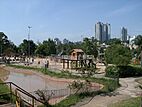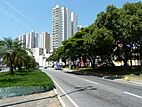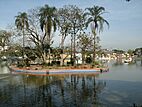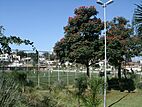Guarulhos facts for kids
Quick facts for kids
Guarulhos
|
|||
|---|---|---|---|
|
Municipality
|
|||
| Municipality of Guarulhos | |||
|
|
|||
|
|||
| Nickname(s):
Cidade Progresso (Progress City)
|
|||
| Motto(s): | |||

Location in São Paulo
|
|||
| Country | |||
| Region | Southeast | ||
| Founded | December 8, 1560 | ||
| Founded by | Manuel de Paiva | ||
| Named for | Guarus Indigenous tribe | ||
| Area | |||
| • Municipality | 318.68 km2 (123.043036 sq mi) | ||
| • Urban | 156.52 km2 (60.4327099 sq mi) | ||
| Elevation | 759 m (2,490 ft) | ||
| Population
(2022)
|
|||
| • Municipality | 1,291,784 | ||
| • Density | 4,053.55/km2 (10,498.636/sq mi) | ||
| Time zone | UTC-3 (BRT) | ||
| Postal Code |
07000-000
|
||
| Area code(s) | +55 11 | ||
| HDI (2010) | 0.763 – high | ||
| Airport | São Paulo–Guarulhos International Airport | ||
| Interstates | |||
| Rapid Transit | CPTM Line 13 | ||
Guarulhos is a large city in Brazil, located in the state of São Paulo. It's the second most populated city in São Paulo state and the 13th largest city in all of Brazil. What's cool is that it's the biggest city in Brazil that isn't a state capital! Guarulhos has grown a lot recently, even becoming bigger than Campinas. It's part of the Metropolitan Region of São Paulo, which is a huge urban area. The city has about 1.3 million people and covers an area of 318.68 square kilometers.
Contents
About Guarulhos: A City of Progress
The name Guarulhos comes from the Tupi language. It means "Eaters" or "big-bellied people." This name refers to the native people who lived in this area long ago.
Guarulhos is a very important city for Brazil's economy. It ranks eighth in terms of its Gross Domestic Product (GDP) among all Brazilian cities, and second in the state of São Paulo. This means a lot of money is made here through businesses and industries. It's also one of the ten largest suburbs in the world!
One of the biggest reasons Guarulhos is so important is because it's home to São Paulo-Guarulhos International Airport (GRU). This is one of the main airports in Brazil, connecting the country to the rest of the world. The city is also where the main church for the Roman Catholic Diocese of Guarulhos is located.
Protecting Nature in Guarulhos
Guarulhos is not just about city life; it also has important natural areas. Part of the Cantareira State Park is located here. This park was created in 1962 and helps protect a big part of the water supply for the entire São Paulo metropolitan area.
The city also includes a section of the Mananciais do Rio Paraíba do Sul Environmental Protection Area. This large area was set up in 1982 to protect the sources of the Paraíba do Sul river, which is a vital water source.
History of Guarulhos: From Village to Big City
Guarulhos was founded a long time ago, on December 8, 1560. It was started by a Jesuit priest named Manuel de Paiva. He named it Nossa Senhora da Conceição. The village was one of several small settlements built to protect the main village of São Paulo de Piratininga from the Tamoios, a group of native people living in the region.
Early Days and Strategic Location
In the 1500s, Guarulhos was in a very important spot. It was right next to what would become São Paulo's capital city. It was also surrounded by two rivers: the Tietê to the south and the Cabuçu de Cima to the west. Around the same time, another village, São Miguel, was founded for similar reasons. Today, that area is known as São Miguel Paulista District in São Paulo.
In 1880, Guarulhos became independent from São Paulo and was named Nossa Senhora da Conceição dos Guarulhos. Its current name, Guarulhos, was officially adopted later, on November 6, 1906.
Growth and Development in the 20th Century
At the start of the 1900s, Guarulhos began to grow rapidly. A railroad was built, and an electricity system was installed. People also started asking for telephone services. Many new factories and businesses opened, and public transportation began.
In the 1930s, the city saw some big changes due to important events in Brazil's history, like the Federal Intervention and the Constitutional Movement. These events marked the end of an old era in Brazil.
The 1940s were a time of progress for Guarulhos. The Monteiro Lobato Municipal Library was opened in 1940. The city's first Health Center opened in 1941. Ten years later, the Holy House of Mercy of Guarulhos was built. During this decade, many different types of factories came to the city, making things like electronics, metal products, plastics, food, rubber, shoes, and even clocks.
In 1945, the São Paulo's Air Force Base (BASP) moved from a small airport in São Paulo to the Cumbica neighborhood in Guarulhos. In 1958, the Rotary Club started a branch in the city, and the Municipal Conservatory of Guarulhos was founded in 1961.
In 1963, the Commercial & Industrial Association of Guarulhos was created. Today, it's known as the Commerce & Business Association of Guarulhos (Associação Comercial e Empresarial de Guarulhos – ACE).
Industrial Boom and Population Growth
The growth of factories and industries brought many new people to Guarulhos. These new residents settled in urban areas, and the city's population exploded. It grew from 35,000 people in 1950 to 101,000 in 1960. By 1980, it had reached over half a million people! Most of these new citizens worked in the factories in Guarulhos, which had around 2,000 businesses, or in nearby São Paulo.
In 1985, the Cumbica Airport officially opened. Today, it's known as the "International Airport of São Paulo–Guarulhos Governor André Franco Montoro." It's the second-biggest airport in Latin America!
Between 2000 and 2006, Guarulhos's population grew three times faster than the rest of São Paulo State. According to the IBGE, Guarulhos is the second most populated city in the state, right after São Paulo's capital. Most of its people are working and contributing to the city's economy.
Famous People from Guarulhos
Many talented people come from Guarulhos, including:
- Rebeca Andrade, a famous gymnast.
- Natália Araujo, a Brazilian indoor volleyball player who was a World Championship runner-up.
- Marques Batista de Abreu, a footballer who later became a politician.
- Cristiano Marques Gomes, a footballer.
- Edson Ribeiro, a sprinter.
- Mamonas Assassinas, a popular rock band from the 1990s.
- David Braz, a footballer.
- Gabriel Martinelli, a footballer.
- Jaimerson Xavier, a footballer.
- David da Silva, a footballer.
- Vinícius Silvestre, a footballer.
- Any Gabrielly, a singer, actress, dancer, and model.
Weather in Guarulhos
Guarulhos has a climate with fairly warm temperatures and rain spread out throughout the year. It's known as a "Humid Subtropical Climate." This means it doesn't get too cold, and there's usually enough rain to keep things green.
| Climate data for Guarulhos (1981–2010) | |||||||||||||
|---|---|---|---|---|---|---|---|---|---|---|---|---|---|
| Month | Jan | Feb | Mar | Apr | May | Jun | Jul | Aug | Sep | Oct | Nov | Dec | Year |
| Mean daily maximum °C (°F) | 29.2 (84.6) |
29.4 (84.9) |
28.5 (83.3) |
26.9 (80.4) |
23.9 (75.0) |
23.0 (73.4) |
22.8 (73.0) |
24.5 (76.1) |
24.8 (76.6) |
26.6 (79.9) |
27.6 (81.7) |
28.4 (83.1) |
26.3 (79.3) |
| Daily mean °C (°F) | 23.4 (74.1) |
23.5 (74.3) |
22.8 (73.0) |
21.3 (70.3) |
18.5 (65.3) |
17.1 (62.8) |
16.6 (61.9) |
17.8 (64.0) |
18.8 (65.8) |
20.4 (68.7) |
21.5 (70.7) |
22.5 (72.5) |
20.4 (68.7) |
| Mean daily minimum °C (°F) | 19.1 (66.4) |
19.2 (66.6) |
18.6 (65.5) |
17.1 (62.8) |
14.3 (57.7) |
12.5 (54.5) |
12.0 (53.6) |
12.7 (54.9) |
14.1 (57.4) |
15.8 (60.4) |
16.9 (62.4) |
18.1 (64.6) |
15.9 (60.6) |
| Average precipitation mm (inches) | 269.1 (10.59) |
224.9 (8.85) |
203.9 (8.03) |
86.6 (3.41) |
79.0 (3.11) |
41.7 (1.64) |
48.5 (1.91) |
32.1 (1.26) |
88.9 (3.50) |
122.5 (4.82) |
134.8 (5.31) |
226.8 (8.93) |
1,558.8 (61.37) |
| Average precipitation days (≥ 1.0 mm) | 16 | 14 | 14 | 7 | 7 | 4 | 4 | 3 | 7 | 9 | 10 | 15 | 110 |
| Average relative humidity (%) | 75.4 | 75.5 | 75.5 | 74.6 | 75.9 | 75.4 | 74.1 | 69.9 | 72.6 | 73.7 | 73.0 | 75.0 | 74.2 |
| Mean monthly sunshine hours | 141.1 | 136.6 | 156.1 | 162.1 | 157.5 | 155.2 | 162.0 | 169.9 | 127.2 | 138.2 | 145.2 | 139.5 | 1,790.6 |
| Source: Instituto Nacional de Meteorologia | |||||||||||||
Getting Around: Transportation in Guarulhos
Guarulhos has good transportation links. The main highway that serves the city is the Rodovia Presidente Dutra. This road connects São Paulo to Rio de Janeiro.
In 2018, a new train line opened. It's called Line 13–Jade of the Companhia Paulista de Trens Metropolitanos (CPTM) system. This line connects São Paulo–Guarulhos International Airport to Engenheiro Goulart station. Soon, Guarulhos will also get its first São Paulo Metro line, called Line 19–Sky Blue.
The São Paulo Air Force Base - BASP, which is a base for the Brazilian Air Force, is also located in Guarulhos.
Media and Communication
For telecommunications, Guarulhos was originally served by a company called Telecomunicações de São Paulo. In 1998, this company was bought by Telefónica, which later became known as Vivo in 2012. Today, Vivo provides cell phone services, landlines, internet (using fiber optics and 4G), and television (satellite and cable) to the city.
See also
 In Spanish: Guarulhos para niños
In Spanish: Guarulhos para niños









